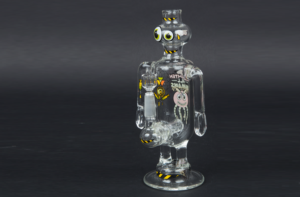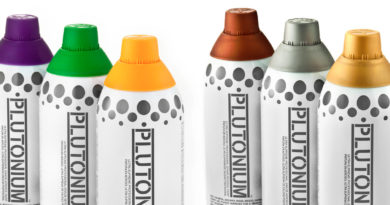Jerome Baker , sets new BenchMark for Glass blowing industry.
Jerome Baker revolutionised the glass blowing industry in the 90’s and was one of the key figures in the glass piping movement, changing the way smokers around the world enjoy their herb. Today, Baker is aiming to revolutionise the bottled water industry, and maybe save the planet in the process. It all started at a Grateful Dead show in Denver in 1989, when someone passed Jerome Baker (not his real name) a pipe like he had never seen before: it was made of glass, with a pushed-in glass bowl, and it “made the herb taste the best that I had ever tasted.” Not only that, he noticed that as he smoked out of it, it appeared to change colours. Baker was amazed, and eager to learn more. These two features – fuming and the pushed-in bowl -were huge steps forward in the development of pipe design, and they were employed almost exclusively at the time by Bob Snodgrass, the Oregon glassblower who had made the pipe Baker had sampled in Denver.
As luck would have it, Baker was already planning to move to Oregon, so when he arrived he looked up “Snodgrass” in the phone book, called the only number listed, and was soon hanging out with the now-legendary glass artist while he did flamework in the back of his trailer. At that point, there were a grand total of three glassblowers worldwide, all in the Eugene, Oregon area, who were making these innovative pieces. Baker wanted to learn their craft, so he saved up for some glassblowing equipment and he and a friend taught themselves the basics. When he was ready, Snodgrass took him under his wing, teaching and inspiring him to create not just pipes, but art. Later, Baker went to what he calls “the epicenter of glass art,” Pilchuck Glass School, where he studied at the feet of master glass artists from around the world. Not long afterward, on the day Jerry Garcia died, he created JBD, Jerome Baker Designs (Jerome for Jerry, Baker for what you do with the pipe) to take his art and innovations to a global audience. The glass art scene was exploding in Eugene, so he hired a crew of talented blowers and quickly made JBD synonymous with quality, functionality and beauty in glass pipes. Just three years later, in 1998, Baker won the first-ever glass award at the High Times Cannabis Cup in Amsterdam. He won again in 2002, confirming to the wider world what was already known in the cannabis community: Jerome Baker pipes had become the standard against which all others were judged. Success of this kind unfortunately sometimes draws attention from the wrong people. A few months later, Baker and 54 other individuals around the U.S. were indicted on charges of selling drug paraphernalia. JBD was closed permanently, ending a crucial chapter in the history of pipe design. After serving a short time in prison, Baker was approached, while on parole, to be the lead designer for a new state-of-the-art glassblowing program at the University of Oregon. There he was able to teach students some of the techniques he had refined over his then-14-year career as a glass artist. When he came to the end of his parole, Baker opted to leave Oregon for a sunnier climate: “I wanted to make sure that I’m fully, thoroughly enjoying life.” So he sold everything (everything that hadn’t been seized by the government, that is) and moved to Hawaii, where he has since spent his days surfing, meditating, raising a family and planning his next move. Baker has always been environmentally conscious, so whatever he did next, it would be eco-friendly. Living in Hawaii made him aware of the Great Pacific Garbage Patch, a floating, Texas-sized patch of non-biodegradable plastic debris north of Hawaii. He began to notice how commonplace plastic is in everyday life; from the food we buy to the interior of our vehicles, we are surrounded by plastic, a distressingly large portion of which eventually finds its way to our oceans and leeches toxic chemicals into our food chain. Plastic water bottles in particular are not only collecting in landfills and on the ocean (2.7 million tons of plastic are used for water bottles each year, and less than 15% of those are ever recycled) but they also release harmful chemicals into the human body. Apalled by the sheer volume of plastic consumption he saw around him, Baker realised that he was in a unique position to promote the use of a much more environmentally-safe material, the one to which he has devoted his adult life: glass. Inspired, he set out to design a water bottle and fill it with the purest drinking water available. The Binger Springs water bottle is not only visually arresting, it is an homage to glass culture and the pipers whose vision and drive have turned the act of smoking into an aesthetic experience. It is reusable, 100% recyclable and filled with triple-reverse-osmosis filtered, neutral alkaline water from Canada. More than a beverage or a tribute to a subculture, the Binger Springs bottle is a thinkpiece, urging the consumer to consider how his actions affect the world at large, hopefully inspiring change. Baker’s plans to save the world don’t end there. His long-term goal includes converting an old oil rig into a floating city (or at least a floating party, complete with entertainment), powered by plastic from the Great Pacific Garbage Patch that would be reconstituted into oil right there on the ship. Using recyclables to power recycling–now that’s an idea that could change the world. In the meantime, Baker has been working with designers at RooR on a limited-edition piece that will be a collaboration in the fullest sense of the term, fusing Baker’s style with Roor’s hallmark design and flawless craftsmanship. The special edition will be individually numbered, with a full accessory kit and a carrying case. Given the two names associated with this project, you might want to get your order in now. Whatever Jerome Baker does, he does it big. Whether he’s founding the first major international glass pipe company, establishing a glassblowing program at a major university or introducing a new water bottle, Baker doesn’t just push the industry forward, he subtly alters our relationship to the products we use, opening our minds to new ways of thinking. If he has his way, we may never look at bottled water the same way again. Let’s hope he succeeds.





